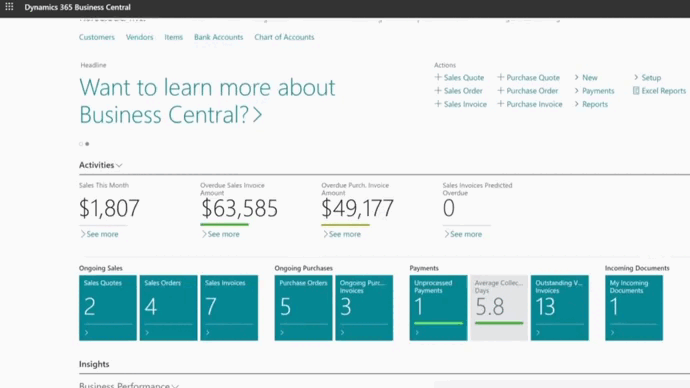In the fast-moving world of modern business, Enterprise Resource Planning (ERP) software has become a critical asset. They empower us to simplify operations, supercharge efficiency, and propel growth. Yet, for many of us in the decision-making realm, the journey to understanding the tangible impacts of ERP software and navigating the myriad solutions on offer can seem a little overwhelming.
This article delves into the world of ERP software through practical examples, successful ERP implementation examples, stories, and common challenges faced during implementation. By examining the experiences of three distinct companies—Company A, renowned for its exceptional manufacturing capabilities; Company B, a leader in supply chain optimization; and Company C, an innovator in e-commerce—we illustrate the significant impact of ERP solutions.
We will discuss the frequent mistakes and issues these organizations encounter, providing valuable advice for those considering ERP. We will also review the various ERP software options available on the market, emphasizing the importance of selecting the right system for your industry.
Explore the world of ERP systems, learn about their great features, read about real-life success stories and challenges, and explore the wide range of Enterprise Resource Planning solutions.
Understanding ERP systems: the backbone of modern business transformation
In today's ever-evolving business landscape, Enterprise Resource Planning (ERP) systems stand as the bedrock upon which organizations build their pathways to efficiency, productivity, and sustainable growth. In this section, we’ll delve deeply into the essence of ERP softwares. We’ll explore their multifaceted nature, the numerous benefits they bring to organizations, and the wide variety of ERP solutions available on the market. We’ll also provide real-life examples of ERP systems.
Defining ERP systems and their core functionalities
At the heart of every successful organization lies a well-implemented ERP. ERP is a comprehensive suite of integrated software solutions that streamlines and centralizes various critical business processes and functions. These functions can encompass everything from finance and human resources to supply chain management, inventory control, and customer relationship management.
The core functionalities of ERPs extend far beyond simply managing data. They integrate and manage core business processes, enabling businesses to automate repetitive tasks, improve data accuracy, and provide a single source of truth for decision-makers. ERP acts as the digital nerve center that connects different departments, guaranteeing a seamless flow of information and fostering collaboration.

Benefits of successful ERP implementation for organizations
ERP systems offer widespread benefits, enhancing efficiency, productivity, and profitability across business operations. They improve data management, ensuring accuracy for compliance and risk mitigation. By consolidating data from various departments into a single platform and eliminating silos, ERP systems reduce errors from manual entry and disparate sources, enhancing decision-making with reliable, timely data.
Additionally, ERPs provide real-time operational insights, allowing companies to make informed decisions, spot trends, and preemptively address issues, crucial in today's fast-paced market. They also streamline processes, automate tasks, and optimize resource use, as demonstrated in successful ERP implementations. This not only cuts costs but also allows staff to focus on strategic goals, innovation, and customer engagement.
Ready to adopt an ERP system?
Contact our team today and book a free consultation to discover Microsoft Dynamics 365 Business Central, one of the top ERP software.
 Free discovery call
Free discovery call
The diversity of ERPs available
Enterprise resource planning systems are a wide range of software systems. Each system is made to meet the specific needs of different industries, businesses, and operating models, as shown in ERP systems examples. Whether you’re a manufacturing powerhouse, a logistics wizard, a service-oriented enterprise, or a retail magnate, there’s an ERP designed to align with your unique requirements.
The wide range of ERP softwares, as seen in real-life examples, shows how these systems can be changed and grew. Companies like Gestisoft understand that every business is unique. Therefore, they offer customizable solutions that adhere to the specific standards and regulations of each industry. Whether you want to be compliant in strict industries or grow quickly in new markets, there’s an ERP software that can be made to fit your needs.
In the next parts of this article, we’ll look more closely at ERP systems. We’ll look at more real-life success stories, look at common mistakes to avoid, and talk about the important things to do to get ERPs to work well. It’s essential to take note of examples of ERP software to learn from them.
Case study
Discover how Bédard Ressources made its accounting more efficient with Business Central
 Download
Download
SAP ERP:
SAP ERP is a globally recognized ERP software known for its extensive functionality. It caters to large enterprises across various industries.
Key Features:
- Comprehensive suite covering financials, supply chain, HR, and more.
- Advanced analytics and reporting capabilities.
- Industry-specific solutions such as SAP S/4HANA for Manufacturing.
Strengths:
- Seamless integration with other business applications.
- Suitable for complex supply chain management.
- Ideal for enterprises seeking comprehensive solutions.
Oracle ERP Cloud:
Oracle ERP Cloud is a scalable and adaptable cloud-based ERP software catering to businesses of all sizes. It offers a wide range of modules.
Key Features:
- Highly customizable and flexible.
- Robust reporting and analytics tools.
- Strong compliance and security features.
Strengths:
- Suitable for both small and large enterprises.
- Supports data-driven decision-making.
- Ideal for heavily regulated industries.
Microsoft Dynamics 365:
Microsoft Dynamics 365 integrates seamlessly with the Microsoft ecosystem, providing a unified experience. It offers modules for various business functions.
Key Features:
- AI-driven insights and automation.
- Integration with Microsoft Office, SharePoint, and Power BI.
- Modules include Sales, Marketing, Finance, and Operations.
Strengths:
- Enhances productivity and customer engagement.
- Offers a unified platform for Microsoft users.
- Enhances financial management and production processes
- Offers a integration with a customer relationship management crm with Microsoft dynamics 365
- Tailorable to specific business needs.
NetSuite:
NetSuite is a cloud-based ERP system ideal for businesses with e-commerce operations. It offers modules for financial management, e-commerce, CRM, and more.
Key Features:
- Real-time dashboards and reporting tools.
- Robust order management capabilities.
- Support for businesses with e-commerce operations.
Strengths:
- Provides real-time visibility into financials.
- Enhances competitiveness for e-commerce businesses.
- Offers a suite of integrated solutions.
Infor CloudSuite:
Infor CloudSuite provides industry-specific ERP with advanced features like predictive analytics and AI-driven decision support.
Key Features:
- Modern, user-friendly interface.
- Scalable and flexible solutions.
- Industry-specific modules for various sectors.
Strengths:
- Enhances operational efficiency.
- Suitable for businesses seeking industry-specific solutions.
- Supports growth and adaptability.
Epicor ERP:
Epicor ERP targets manufacturing, distribution, and retail sectors. It offers features like inventory management, production planning, and CRM.
Key Features:
- Focus on growth and efficiency.
- Comprehensive suite tailored to specific industries.
- Robust inventory and production management tools.
Strengths:
- Ideal for businesses in manufacturing and distribution.
- Enhances efficiency and competitiveness.

Acumatica:
Acumatica is a flexible cloud-based ERP system suitable for businesses of various sizes and industries. It offers modules for financial management, project accounting, and distribution management.
Key Features:
- Scalable and adaptable to diverse needs.
- User-friendly interface.
- Modules for financial management and project accounting.
Strengths:
- Suitable for businesses with varying requirements.
- Promotes efficiency and adaptability.
- Provides a smooth user experience.
These ERP systems cater to a wide range of industries and business sizes. The choice of the right ERP solution depends on your specific business needs, industry, and operational goals. The diversity within the ERP landscape ensures that businesses can find the perfect fit for their unique circumstances.
How much can you save with Business Central?
Download your free ROI Excel calculator to discover how much ROI you can expect when you implement Business Central today.

Successful ERP implementation example 1: Company A - a manufacturing marvel
Company background and operational challenges
In the heart of a bustling industrial town, Company A stood as a well-established manufacturing powerhouse with a rich history spanning several decades. However, the passage of time had exposed them to a common challenge in the manufacturing realm: operational inefficiency.
Despite their legacy of producing high-quality goods, inefficiencies plagued Company A’s operations. With disparate systems for production, inventory management, and order processing, they grappled with delays, errors, and mounting operational costs. Manual data entry was a persistent bottleneck, leading to missed deadlines and dissatisfied customers.
The cost of these problems was big. Company A thought it’d lose a lot of money because it wasted resources, had to take time off, and had to pay more for workers.
The ERP transformation journey
Recognizing the need for a comprehensive solution, Company A embarked on a transformative journey by embracing Enterprise Resource Planning (ERP) software. This marked a pivotal moment in their quest for efficiency and competitiveness.
The ERP implementation project began with a dedicated team of experts and consultants. The initial phase involved an exhaustive analysis of Company A's existing processes, followed by the tailored design of an ERP solution. This phase, including comprehensive employee training, spanned approximately three months.
Investment and costs
While the upfront investment in ERP was substantial, Company A viewed it as a long-term commitment that promised significant returns. They allocated approximately $1.5 million for the ERP software, customization, implementation, data migration, hardware upgrades, and employee training.
Post-ERP improvements and savings
The implementation of the ERP system yielded remarkable improvements across various facets of Company A's operations, with notable cost savings.
Order Processing Efficiency: 40% thanks to automated order entry and real-time inventory tracking slashed order processing times. This not only improved customer satisfaction but also reduced labor costs related to manual order processing.
Inventory Optimization: Streamlined inventory management resulted in a 25% reduction in excess inventory. This led to lower carrying costs, minimized wastage, and estimated annual cost savings of $800,000.
Downtime Reduction: The ERP system facilitated predictive maintenance, decreasing equipment downtime by 30%. This enhancement directly impacted production output, leading to increased revenue.
Return on investment (ROI)
As a result of the swift implementation and resulting cost savings, Company A was able to recoup their investment in ERP within a span of two years. The new inventory management system and less downtime helped the company make a lot of money. It also made the company work better overall. This demonstrated that the ERP investment was not merely an expenditure, but a strategic decision that enhanced the profitability of the company.
Lessons learned and key takeaways
Reflecting on their ERP journey, Company A underscored the critical importance of change management. Transitioning to the new system necessitated substantial adjustments from employees accustomed to their old workflows. Effective communication, training, and support emerged as pivotal factors in overcoming resistance and ensuring a seamless transition.
Customization of the ERP system to align with their unique manufacturing processes emerged as non-negotiable. This tailored approach allowed Company A to maximize the system's benefits and meet their specific needs.
Ultimately, the story of Company A serves as evidence of the significant impact that a well-planned and tailored implementation of an ERP can have. It highlights the potential for significant returns on investment and improved operations, showcasing how these systems can enhance business profitability.
Insights from our manufacturing white paper
Solutions to navigate challenges and drive digital transformation in the Canadian manufacturing industry

Successful ERP implementation example 2: company B - Supply chain optimization
Company background and supply chain management challenges
In a world where supply chain efficiency is paramount, Company B emerged as a specialist in supply chain optimization. However, they faced their own set of challenges in an increasingly competitive market.
Company B's business revolved around managing complex supply chains for their clients. Their legacy systems struggled to keep pace with the dynamic demands of modern supply chains. Disconnected processes, manual data entry, and a lack of real-time visibility into inventory and logistics were hindering their ability to deliver on their promise of efficiency.
The financial impact was significant. Inaccurate inventory tracking led to overstocking and stockouts, increasing carrying costs and leading to missed sales opportunities. The need for change was evident.
The ERP transformation journey
Company B embarked on an ambitious journey to revolutionize their supply chain management. They recognized that Enterprise Resource Planning (ERP) was the key to optimizing their operations and meeting the demands of their clients. Project management played a crucial role in the ERP implementation process, ensuring comprehensive oversight and automation of project tasks.
The ERP implementation project kicked off with a dedicated team of experts. The initial phase involved an in-depth analysis of Company B’s supply chain processes and the tailoring of an ERP solution to meet their unique needs. This phase, including comprehensive employee training, took approximately four months.
Investment and costs
Company B understood that to achieve supply chain excellence, a significant investment was required. They allocated approximately $2 million for the ERP software, customization, implementation, data migration, hardware upgrades, and extensive employee training.
Post-ERP improvements and savings
The implementation of the ERP system brought about substantial improvements across Company B's supply chain operations, along with notable cost savings.
Company B could see how much inventory they had in real time. This helped them save 30% on carrying costs. Accurate demand forecasting led to more efficient stock management.
Streamlined Logistics: Automated logistics and route optimization reduced transportation costs by 20%. This not only saved money but also improved delivery times and customer satisfaction.
Company B improved customer services by using a central ERP system. The system gave real-time updates on orders and inventory availability.
Return on investment (ROI)
The ERP investment paid off swiftly. Company B made money back in three years. This shows how much money the ERP system saved and how well it worked.
Lessons learned and key takeaways
In hindsight, Company B emphasized the importance of comprehensive ERP customization to align with their intricate supply chain processes. It allowed them to harness the full potential of the ERP system and cater to their clients' specific needs.
Effective change management played a pivotal role, ensuring that employees embraced the new system. Training and support were key elements in facilitating a smooth transition.
Ultimately, Company B's experience shows the cost-saving and efficiency-enhancing benefits of implementing an ERP system tailored for the supply chain. Their decision to invest in ERP resulted in not only streamlining their supply chain operations, but also strengthening their position in the market. This serves as proof of the significant impact that an ERP can have when customized to address the specific demands of a specialized sector.
Successful ERP implementation example 3: Company C - e-commerce excellence with ERP systems
Company background and e-commerce challenges
In the bustling world of e-commerce, Company C had carved a niche for itself as a trailblazer in delivering exceptional online shopping experiences. However, they faced unique challenges in the ever-evolving digital landscape.
Company C's business thrived on delivering seamless online shopping experiences to a diverse customer base. However, their legacy systems were struggling to keep up with the dynamic demands of e-commerce. Manual order processing, broken customer data, and not having real-time information about inventory were stopping them from staying great.
Recognizing the need for change, Company C sought an innovative solution that’d improve their e-commerce operations without breaking the bank.

The budget-friendly ERP transformation journey
Company C embarked on a journey to revolutionize their e-commerce operations through the adoption of an Enterprise Resource Planning (ERP) system. They made customer relationship management (CRM) an important part of their ERP system. They connected it to different business functions to manage operations better and make decisions better using data from one place. However, they approached the project with a budget-conscious mindset, determined to make the most of their resources.
The ERP implementation project kicked off with a small but dedicated team of experts. They opted for a pre-configured ERP solution that required minimal customization, allowing them to reduce implementation time and costs significantly. The initial phase, including employee training, took about two months.
Investment and cost efficiency
Company C's budget-conscious approach extended to the ERP investment. They allocated approximately $500,000 for the pre-configured ERP software, limited customization, streamlined implementation, and employee training.
Post-ERP improvements and savings
Despite the budget-conscious approach, the implementation of the ERP system brought about substantial improvements across Company C's e-commerce operations, with notable cost savings.
Automated order processing made orders take 25% less time to be processed. This made customers happier and delivered faster.
Real-time Inventory Insights: The ERP system provided real-time inventory insights, reducing overstocking and stockouts by 20%. This led to reduced carrying costs and optimized inventory management.
Marketing Efficiency: Streamlined customer data and marketing automation tools improved marketing efficiency, resulting in a 15% increase in online sales.
ERP self-evaluating guide
Optimize your ERP software performance by identifying potential areas for improvement through our practical guide.

Return on investment (ROI)
Company C's budget-conscious ERP investment yielded remarkable results. They achieved a return on investment within four years, a testament to their cost-efficient approach and the substantial improvements brought about by the ERP system.
Lessons learned and key takeaways
Company C said it’s important to use a balanced approach to ERP implementation. They showed that even with a smaller budget, big improvements can be made. Choosing a pre-configured ERP system and limiting customization helped them achieve efficiency without breaking the bank.
Change management remained a key focus, ensuring that employees adapted to the new system effectively. Training and support played vital roles in the smooth transition.
In conclusion, Company C's journey underscores the value of cost-conscious ERP implementations. Their experience showcases that even with budget constraints, an ERP system can lead to significant cost savings and operational enhancements. It's a testament to the adaptability and transformative power of ERP solutions in meeting the specific needs of an e-commerce pioneer.

Importance of selecting the right ERP solution
Selecting the right ERP system is akin to choosing the perfect tool for a specific job. This is a big decision that can greatly affect your company’s efficiency, competitiveness, and ability to adapt to changing market conditions. Real-life ERP systems examples show this. The process involves a meticulous evaluation of your business’s unique requirements, scalability considerations, and customization options.
ERPs aren’t just software—they’re strategic investments that can shape the future of your organization. Choosing an ERP solution that aligns with your industry, operational needs, and long-term goals is paramount to achieving a successful implementation and reaping the benefits of ERP adoption.
Addressing the customization of ERP solutions
ERP systems are, by nature, adaptable and customizable to meet the unique workflows and processes of organizations, just as demonstrated in ERP systems examples. This level of customization ensures that the ERP solution becomes an integral part of your organization, seamlessly aligning with your business objectives.
Customization can range from configuring specific modules to match industry-specific standards to tailoring workflows to fit your unique operational model. The goal is to make the ERP system work well with your company’s processes. This will help your organization be more efficient, accurate, and competitive.

Exploring methods for evaluating ROI in successful ERP implementation projects
Measuring the return on investment (ROI) in ERP projects is a crucial step in assessing the success and effectiveness of the implementation. Various methodologies and metrics are employed to quantify the financial impact of ERP systems, as demonstrated in real-world ERP systems examples. These metrics include calculations of cost savings, revenue increases, and reductions in operational expenses directly attributed to the ERP implementation.
Evaluating ROI provides organizations with a tangible measure of the financial benefits derived from ERP adoption. It allows decision-makers to gauge the effectiveness of their ERP investment and make informed decisions regarding future strategies.
Identifying key performance indicators (KPIs) for tracking ERP performance
Key performance indicators (KPIs) play a pivotal role in monitoring the ongoing performance of ERP systems, as illustrated in real-life ERP systems examples. These KPIs encompass a wide range of metrics, including process efficiency, data accuracy, customer satisfaction, and more.
KPIs tailored to an organization's specific goals and objectives enable continuous assessment of the ERP system's effectiveness. By regularly monitoring these KPIs, organizations can identify areas for improvement and make data-driven decisions to enhance ERP system performance.
Setting realistic timelines for achieving ROI
Achieving a positive ROI is a significant milestone in any ERP implementation. However, it's essential to set realistic timelines for realizing this return, as highlighted by real-world ERP systems examples. ERP projects often involve initial investments in software, training, and infrastructure, which can take time to generate returns.
Organizations must know when to expect their money back and think about how long it’ll take for employees to learn the new ERP system. Setting realistic timelines ensures that organizations maintain a clear view of their financial objectives and can manage expectations accordingly.
Summarizing the transformative potential of ERP systems through real-world examples
Throughout this article, we have embarked on a journey through the world of ERP systems, guided by real-world success stories and lessons learned. From Company A’s amazing manufacturing to Company B’s supply chain optimization and Company C’s e-commerce success, we have seen how ERP systems can change businesses across different industries. These examples show how ERP systems can do this.
These real-world examples serve as beacons of inspiration for organizations contemplating ERP adoption. They underscore the transformative potential of ERP systems when strategically implemented and aligned with organizational goals. The path to ERP success isn't without its challenges, but as we've seen, these challenges can be overcome with careful planning and perseverance.
The stories of these organizations serve as powerful testimonies to the possibilities that ERP systems offer, as highlighted by ERP systems examples. We encourage organizations to explore these possibilities, learn from the experiences shared in this article, and embark on their own journeys towards transformation. With the right plan, commitment, and flexibility, ERP systems can open new doors and help businesses succeed in the fast-paced world of modern business.
In a fast-changing business world, ERP systems are still a key part of efficient operations, data-driven decision-making, and competitive advantage. Real-world ERP systems examples show this. As we look to the future of ERP, it is clear that these systems will continue to adapt and evolve to meet the changing needs of organizations.
ERP solutions aren’t just software—they are strategic assets that can shape the destiny of organizations. By realizing how important and important ERP systems are, businesses can be successful in a world that changes all the time. They can use ERP systems to achieve their goals by using them to change how they work.
Ready to start you digital transformation?
Reach out to our expert sales team to start planning your project.
 Contact Sales
Contact Sales
Liked what you just read? Sharing is caring.

September 08, 2025 by Kooldeep Sahye by Kooldeep Sahye Marketing Specialist
Fuelled by a passion for everything that has to do with search engine optimization, keywords and optimization of content. And an avid copywriter who thrives on storytelling and impactful content.
